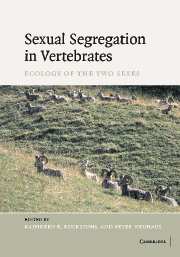Book contents
- Frontmatter
- Contents
- List of contributors
- Preface
- Part I Overview
- Part II Concepts and methodology
- Part III Foraging ecology
- 3 Sex differences in the foraging ecology of large mammalian herbivores
- 4 Sexual segregation in seals
- 5 Sexual differences in foraging behaviour and diets: a case study of wandering albatrosses
- 6 Differences in foraging behaviour and feeding ecology in giant petrels
- Part IV Predator avoidance and reproductive strategies
- Part V Sex-related activities and social factors
- Part VI Sexual differences in ecology: comparisons within different taxa
- Part VII Implications for conservation
- Part VIII Outlook
- References
- Index
6 - Differences in foraging behaviour and feeding ecology in giant petrels
Published online by Cambridge University Press: 04 September 2009
- Frontmatter
- Contents
- List of contributors
- Preface
- Part I Overview
- Part II Concepts and methodology
- Part III Foraging ecology
- 3 Sex differences in the foraging ecology of large mammalian herbivores
- 4 Sexual segregation in seals
- 5 Sexual differences in foraging behaviour and diets: a case study of wandering albatrosses
- 6 Differences in foraging behaviour and feeding ecology in giant petrels
- Part IV Predator avoidance and reproductive strategies
- Part V Sex-related activities and social factors
- Part VI Sexual differences in ecology: comparisons within different taxa
- Part VII Implications for conservation
- Part VIII Outlook
- References
- Index
Summary
OVERVIEW
The two sibling species of giant petrels (northern Macronectes halli and the southern M. giganteus), the dominant scavengers of the sub-Antarctic and Antarctic environment, are one of the best examples of sexual segregation in avian foraging and feeding ecology. During breeding, males and females feed mainly on penguin and seal carrion, but females also feed extensively on marine prey such as cephalopods, fish and krill. Sexual differences in diet are reflected not only in analyses of regurgitations, but also in the isotopic composition of carbon and nitrogen, as well as in their heavy metal burdens. Direct observations and tracking of pelagic movements showed that males of both species usually forage closer to the breeding grounds, exploiting carcasses on beaches, whereas females show more pelagic habits. In consequence, foraging effort, foraging efficiency, predictability of resources exploited, optimum foraging time and activity budgets differ between sexes. During winter, however, studies on activity and pelagic movements suggest more similar feeding habits between sexes. Overall, differences in foraging and feeding ecology are probably related to the substantial sexual size dimorphism; males of both species are 16–35% heavier and have disproportionately larger bills than females. The importance of size in contest competition to access carrion may explain their large body size as well as the competitive exclusion of females from coastal habitats, reducing intraspecific competition for food. Ultimately, a differential exploitation of carrion probably increased sexual dimorphism not only in body size but also in the feeding structures such as bill size.
- Type
- Chapter
- Information
- Sexual Segregation in Vertebrates , pp. 92 - 112Publisher: Cambridge University PressPrint publication year: 2006
- 3
- Cited by



